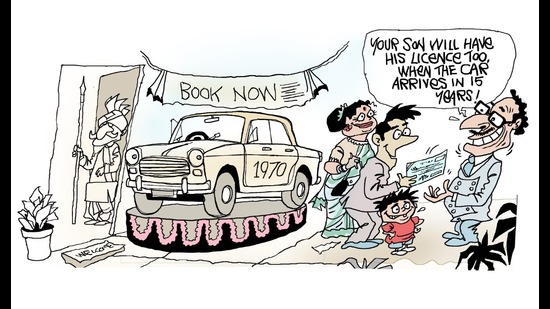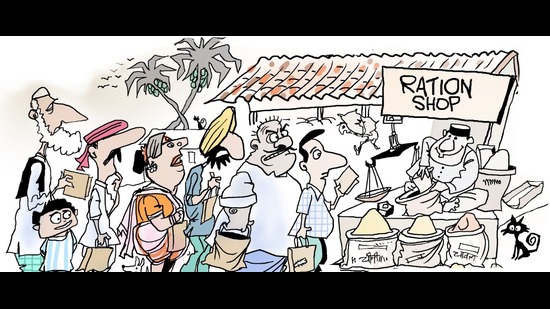We are many, we are one: Ambi Parameswaran on India’s population milestone
An essay on the differing memories, experiences and aspirations of the soon-to-be-1.42 bn, as India heads towards the tag of most populous country in the world.
Demographers in the US have a clean way of defining generations. They are given nice titles and grouped in 15- to 17-year cohorts. Those born between 1916 and 1927 are the Greatest Generation; 1928-45 , the Silent Generation; 1946-64, the Baby Boomers; 1965-80, Gen X; 1981-1997, the Millennials; and 1998-2020, Gen Z.

Classifications for India would necessarily be different. As I see it, there is the pre-Independence generation (1915 to 1935); the first post-Independence generation, or Midnight’s Children (1936-50); the post-Independence idealists (1951-71); the Angry Generation (1972-89); the post-liberalisation generation (1990-2005); and the millennials or the internet generation (2005-20).
Each of these carry memories of the India they grew up in, and those memories shape how they evolve, behave and live. As India approaches the new milestone of most populous country in the world, what will this 1.42 billion consist of?
With life expectancy rising, the number of people over the age of 60 is set to shoot up over the next decade, from 138 million in 2021 to 194 million in 2031. Their worldview, and their view of India, will be vastly different from that of the millennials. Some of their stories of growing up, in a country of shortages and wars, likely sound farfetched to, say, a 25-year-old.
I remember my uncle narrating a story about how he went to the Fiat / Premier showroom in the 1970s, to book a new car. He was carrying a cheque for ₹35,000 as full advance payment. The dealership was virtually empty. It was 4.30 pm and the manager was leaving for the day. Deposit the cheque with the cashier, he told my uncle. The cashier responded that the books were closed and no cheque could be accepted.
My uncle persisted. The cashier wouldn’t budge. Finally, in frustration the latter reportedly said, “Mr Subramanian, why are you insisting? You will get your car only after 15 years, so what difference does it make whether I accept the cheque today or tomorrow?” That’s how long the queue was for a new car.
Fast-forward about 20 years and take an incredible memory from my own work life. We were looking for a larger office in Hyderabad, in 1992. We zoomed in on a particular area in the city, for a very specific reason. What was it? I often ask this question in my talks on branding and management, and I get a myriad answers: it was close to airport, close to client offices, in the city centre.
It was none of these. The criterion we used was: how quickly can we get a landline. In most of Hyderabad, one had to wait five years for a landline at the time. The story sounds bizarre to a 25-year-old today. That’s how much has changed, in the 30 years it took for India to go from a population of about 900 million to the landmark of today.

The older generation, even in affluent homes, remember visiting ration shops to buy commodities such as cooking oil and sugar. Most middle-class Indians under 45 have probably never seen a ration card. They have also never seen the blackout curtains of a country at war; heard the practice air-raid sirens of a country that expects it may be at war again soon.
Today’s 25-year-olds, meanwhile, organise their lives in ways that seem incredible to those who spent most of their lives in this other India. They take loans and launch enterprises, leap into the unknown with fearlessness, embrace change and failure, consume and discard in volumes and patterns that simply did not exist before them.
Taking a loan was seen as taboo until the 1980s. Indian movies painted a grim picture of moneylenders, and said almost nothing about banks. Then taking a loan in order to buy a home became acceptable, and HDFC (the Housing Development Finance Corporation) managed to tap into this trend, becoming the first privately owned giant in this space.

If HDFC took off, it’s because another memory was changing. So many urban Indians under 45 have never lived with a grandparent; the nuclear family needed more homes, smaller homes, homes that could be bought and paid for by one or two salaries.
As an increasingly corporate India developed a massive middle class, loans became a necessary first step; there was no generational wealth funding many of these dreams in the 1980s and ’90s. These were often first-generation holders of asset such as independent homes and cars.
Credit-card companies, who make their profits by revolving credit, were still frustrated, since most people shunned this notion of swiping , and those that were early adopters paid their bills in full each month. Some even figured out how to maximise the credit facility by timing purchases to sync with billing cycles such that they paid no interest at all.
That was then. Today, a growing range of products and services is powered by credit. From two-wheelers to TV sets, holidays and weddings. Living larger than life is the norm, with the result that homes priced at ₹1 crore and ₹2 crore sell easily in the prime metros. Are all those who buy them earning eight-figure salaries? No. But they believe they will be someday. Such aspiration forms the backbone of most dreams in today’s India.
India is now made up of people who lived through queues, and those who had never seen a queue until the pandemic. Those who avoided taking loans and splurging on “luxuries” such as air travel and air-conditioners, and those who seek to leap into tomorrow with purchases made today.
Some new concepts find acceptance across all age cohorts; look at the way digital payments systems have grown with over 500 million smartphone users adopting UPI-enabled platforms. Social media has also been embraced across multiple generations.
Culture and religion form a thread that seems to bind all Indians. In temples, mosques and churches, at festivals and in processions, the young outnumber the old.
They have much to imbibe from each other. The older generations could teach the younger ones the importance of saving; the younger could teach the older the importance of letting their hair down and living for the day (at least once in a while). They pray together, and that’s a sign of health; we could all benefit from praying together too.
The coming decades will pose new challenges, including widening income disparity, climate change, water crises and growing demands for education and healthcare. Hopefully the many generations that call India home will be able to influence each other and find a better balance for a better tomorrow.
(Ambi Parameswaran is a bestselling author of 11 books and an independent brand coach)

All Access.
One Subscription.
Get 360° coverage—from daily headlines
to 100 year archives.



HT App & Website






